Heterologous expression and extracellular secretion of cellulolytic enzymes by Zymomonas mobilis
- PMID: 20693448
- PMCID: PMC2950452
- DOI: 10.1128/AEM.00230-10
Heterologous expression and extracellular secretion of cellulolytic enzymes by Zymomonas mobilis
Abstract
Development of the strategy known as consolidated bioprocessing (CBP) involves the use of a single microorganism to convert pretreated lignocellulosic biomass to ethanol through the simultaneous production of saccharolytic enzymes and fermentation of the liberated monomeric sugars. In this report, the initial steps toward achieving this goal in the fermentation host Zymomonas mobilis were investigated by expressing heterologous cellulases and subsequently examining the potential to secrete these cellulases extracellularly. Numerous strains of Z. mobilis were found to possess endogenous extracellular activities against carboxymethyl cellulose, suggesting that this microorganism may harbor a favorable environment for the production of additional cellulolytic enzymes. The heterologous expression of two cellulolytic enzymes, E1 and GH12 from Acidothermus cellulolyticus, was examined. Both proteins were successfully expressed as soluble, active enzymes in Z. mobilis although to different levels. While the E1 enzyme was less abundantly expressed, the GH12 enzyme comprised as much as 4.6% of the total cell protein. Additionally, fusing predicted secretion signals native to Z. mobilis to the N termini of E1 and GH12 was found to direct the extracellular secretion of significant levels of active E1 and GH12 enzymes. The subcellular localization of the intracellular pools of cellulases revealed that a significant portion of both the E1 and GH12 secretion constructs resided in the periplasmic space. Our results strongly suggest that Z. mobilis is capable of supporting the expression and secretion of high levels of cellulases relevant to biofuel production, thereby serving as a foundation for developing Z. mobilis into a CBP platform organism.
Figures
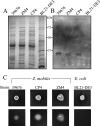

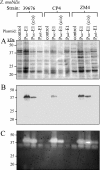
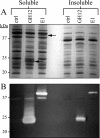
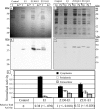
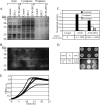
Similar articles
-
Enhancing Secretion of Endoglucanase in Zymomonas mobilis by Disturbing Peptidoglycan Synthesis.Appl Environ Microbiol. 2022 Feb 8;88(3):e0216121. doi: 10.1128/AEM.02161-21. Epub 2021 Nov 24. Appl Environ Microbiol. 2022. PMID: 34818110 Free PMC article.
-
Expression and Extracellular Secretion of Endo-glucanase and Xylanase by Zymomonas mobilis.Appl Biochem Biotechnol. 2019 Jan;187(1):239-252. doi: 10.1007/s12010-018-2821-4. Epub 2018 Jun 19. Appl Biochem Biotechnol. 2019. PMID: 29923149
-
Complete genome sequence of the ethanol-producing Zymomonas mobilis subsp. mobilis centrotype ATCC 29191.J Bacteriol. 2012 Nov;194(21):5966-7. doi: 10.1128/JB.01398-12. J Bacteriol. 2012. PMID: 23045486 Free PMC article.
-
Perspectives and new directions for bioprocess optimization using Zymomonas mobilis in the ethanol production.World J Microbiol Biotechnol. 2020 Jul 13;36(8):112. doi: 10.1007/s11274-020-02885-4. World J Microbiol Biotechnol. 2020. PMID: 32656581 Review.
-
Engineering Zymomonas mobilis for Robust Cellulosic Ethanol Production.Trends Biotechnol. 2019 Sep;37(9):960-972. doi: 10.1016/j.tibtech.2019.02.002. Epub 2019 Mar 13. Trends Biotechnol. 2019. PMID: 30876702 Review.
Cited by
-
Heterologous expression of a glycosyl hydrolase and cellular reprogramming enable Zymomonas mobilis growth on cellobiose.PLoS One. 2020 Aug 14;15(8):e0226235. doi: 10.1371/journal.pone.0226235. eCollection 2020. PLoS One. 2020. PMID: 32797046 Free PMC article.
-
Heterologous expression of plant cell wall degrading enzymes for effective production of cellulosic biofuels.J Biomed Biotechnol. 2012;2012:405842. doi: 10.1155/2012/405842. Epub 2012 Jul 15. J Biomed Biotechnol. 2012. PMID: 22911272 Free PMC article. Review.
-
Engineering microbial factories for synthesis of value-added products.J Ind Microbiol Biotechnol. 2011 Aug;38(8):873-90. doi: 10.1007/s10295-011-0970-3. Epub 2011 Apr 28. J Ind Microbiol Biotechnol. 2011. PMID: 21526386 Free PMC article. Review.
-
Systems biology analysis of Zymomonas mobilis ZM4 ethanol stress responses.PLoS One. 2013 Jul 16;8(7):e68886. doi: 10.1371/journal.pone.0068886. Print 2013. PLoS One. 2013. PMID: 23874800 Free PMC article.
-
Translocation of Zymomonas mobilis pyruvate decarboxylase to periplasmic compartment for production of acetaldehyde outside the cytosol.Microbiologyopen. 2019 Aug;8(8):e00809. doi: 10.1002/mbo3.809. Epub 2019 Feb 15. Microbiologyopen. 2019. PMID: 30770675 Free PMC article.
References
-
- Arnold, K., L. Bordoli, J. Kopp, and T. Schwede. 2006. The SWISS-MODEL workspace: a web-based environment for protein structure homology modelling. Bioinformatics 22:195-201. - PubMed
-
- Bendtsen, J. D., H. Nielsen, G. von Heijne, and S. Brunak. 2004. Improved prediction of signal peptides: SignalP 3.0. J. Mol. Biol. 340:783-795. - PubMed
-
- Brestic-Goachet, N., P. Gunasekaran, B. Cami, and J. Baratti. 1990. Transfer and expression of a Bacillus licheniformis alpha-amylase gene in Zymomonas mobilis. Arch. Microbiol. 153:219-225.
MeSH terms
Substances
Associated data
- Actions
- Actions
- Actions
- Actions
- Actions
LinkOut - more resources
Full Text Sources
Other Literature Sources

